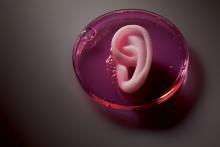It'd be a huge relief to the medical world if we could just make new organs. We've tried faking it with some degree of success--hearts, for example, are somewhat replicable with similar machines, and dialysis can replace kidneys from an external vantage point--but some organs are too subtle to simply swap out with cyborg parts. And some people prefer not to walk around like Darth Vader, with inorganic body parts powering their newly bizarre existence.
Of course, growing organs presents a whole bunch of ethical qualms--not to mention scientific difficulties. I once heard stem cell research dismissed as "murder" during the Bush era when a GOP member defended the president's decision to cut its funding. Anything that even remotely involves potential babies is a huge no-no when it comes to science politics. Even human replication that has very little to do with babies is scorned as science's attempt to play God--even though I've never known God to grow a new kidney for anyone.
But there's a clear need for spare parts. Over 100,000 are on the organ transplant list in the United States at this moment. I and many other people are signed up to be organ donors, but that system doesn't really work until one of us dies. Even then, you've got to have a correct match so that the donor's body doesn't spit the new organ right back up. And every day 18 people on the transplant list die from waiting without results. Bodily breakdown is inevitable, but some of these people have got kids. Some of them are kids. It'd be nice if we could just grow them some more time in a lab in the form of a new body part.
One new solution for the organ shortage comes from one Anthony Atala of the Wake Forest Institute for Regenerative Medicine in Winston-Salem, North Carolina. Atala began growing bladders--not from stem cells, but from the patient's own, broken bladder itself. By taking specific types of cells and allowing them to grow in layers around a cartilage scaffold, researchers could make new, working organs that matched the patient's DNA perfectly. 30 people are currently walking around with functional homegrown bladders. Researchers would like to extend this procedure to even more complicated, solid organs one day.
Other groups of researchers are attempting to grow bioartificial organs as well. Yale made themselves a lung, the University of Michigan grew a kidney, and Columbia managed to produce a jawbone. Not all of them work exactly like the originals--the artificial kidney, for example, must be worn externally, but works more like a kidney than dialysis and has the added benefit of being portable. Researchers are even looking into growing things like ears for soldiers who have lost them.
Ideally, these organs--once perfected--would be grown from stem cells so that they're ready to go when needed. Instead of waiting to grow an organ from a sick patient, doctors could simply select from one of many pre-grown organs after finding a perfect match. It would reduce the amount of time needed for a transplant and greatly improve the likelihood of survival for the patient. Wouldn't it be nice--if maybe a little creepy--if you could just have a kidney transplant like any other standard medical procedure?
